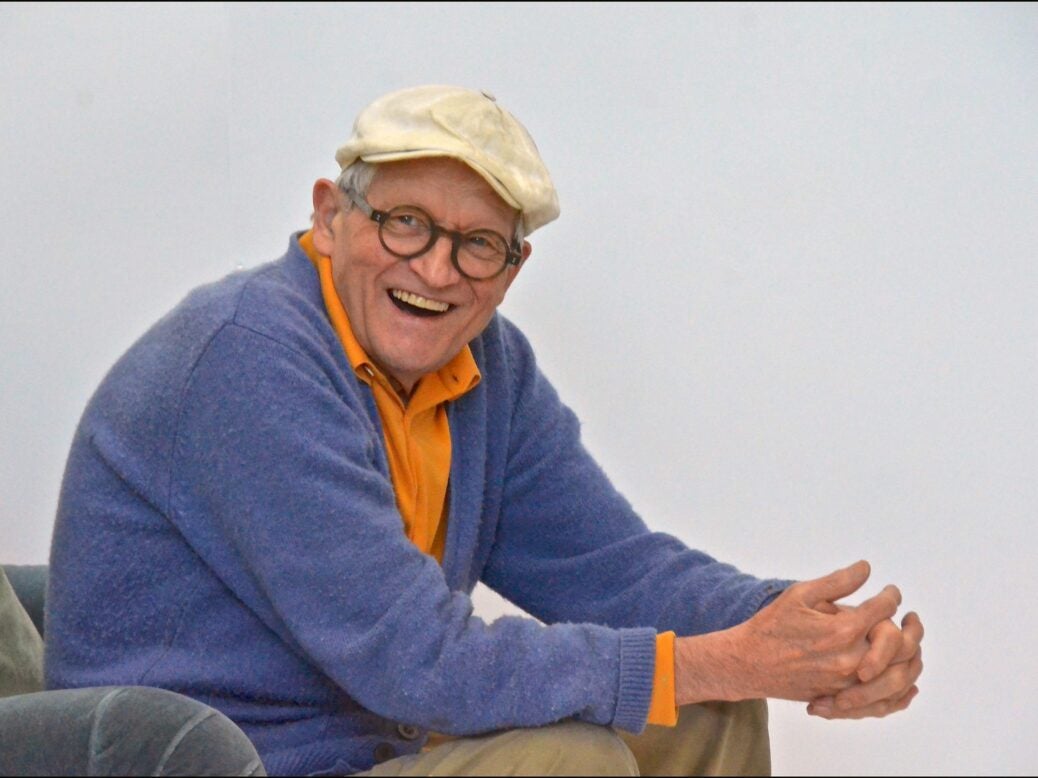
David Hockney already belongs with the greats and he’s not done yet as the current Tate Britain exhibition proves, writes Christopher Jackson
David Hockney has reached such a state of supremacy among contemporary artists that he has only the dead left to compete with. The thrill of Tate Britain’s retrospective – which runs until 29th May 2017, and which definitively secures his reputation – is the sense throughout that we are breathing the air of rarefied competition.
When Hockney paints a portrait he is taking on Rembrandt; when he renders a tree, he has Cézanne in his sights. And if, as in 1977’s My Parents, he paints his mother and father, then he makes sure not only to have a reproduction of Piero della Francesca’s Baptism of Christ in the background, but reflects it in a mirror so that you know he is quietly seeking to outdo Velázquez’ Las Meninas at the same time – all while painting a picture of his own. Every wave he paints is a wrestle with Hiroshige; each sky, a quiet tussle with Titian. Greatness is usually, at least in the first instance, indistinguishable from gumption.

Portrait of an Artist (Pool with Two Figures) 1971
From the beginning, Hockney had this unusual ambition. George Bernard Shaw said of Shakespeare that he never once emitted the apologetic cough of a minor poet. One might say the same of Hockney: and from the first room of this show until the last, we are witness to a roaming, and almost ludicrous, self-confidence. He won his major battles young: another Bradford boy, conscious of his homosexuality, might have fretted a while about the fact of his difference. Not Hockney. In 1961, at the age of 24, he produced the defiant Whitman-inspired We Two Boys Together Clinging. By the age of 27, he was in Los Angeles and producing some of the most important pictures of the 20th century – A Bigger Splash among them.
Those LA pictures with their Edenic sense of leisure – of time passing lazily and sexily in the Californian hills – also depict a world wiped clean of prejudice. It’s as if Hockney intuited Britain’s 1970s decline and wished to make good his pre-emptive escape. There is something of the prophet about Hockney: he has always known his own mind to an unusual degree.
Even the minor LA works on display here evidence a man who cannot have a brush to hand without remaking the world. Take A Lawn Being Sprinkled (1967). Sprinkler-spray does not, if one wished to be factual and tedious about it, look as triangular as this. But it’s still a true picture in another sense: LA must have seemed spruce to a young Yorkshireman liberated and abroad – it is a rendition of happy discovery. The world might rarely look so new as that sky: but who hasn’t sometimes wished that it would?

A Lawn Being Sprinkled, 1967
Every picture in Hockney’s career is a declaration of intent. Whatever else he’s telling you, he’s always letting you know he can do anything. Astoundingly, the rest of his career makes good on that promise.
If one were inclined to think that someone who can do nature so well might struggle to do portraits, here we have a roomful of them proving otherwise. Take this extempore sketch of Ossie Clark. We feel that Hockney knows as much about confident indolence as Clark seems to do: like all great portrait-painters, Hockney works along a series of empathetic hunches. This sketch would ultimately be altered to form part of another great picture Mr and Mrs Clark and Percy (1970-1). In that work – this being Hockney – the artist went into combat with Van Eyck’s greatest picture, The Arnolfini Portrait, the married couple standing for good measure before Hockney’s take on Hogarth’s Rake’s Progress.

Ossie Clark, sketch c. 1970
A track record of fighting the great dead to these honourable draws needed its continuum: but Hockney was running out of past figures to compete with. This exhibition therefore divides in two. Hockney was about to embark on his most important battle of all: with nature. Late Hockney is a distillation, where a certain competitive superfluity has been squeezed out.
It all began with his return to Yorkshire in the 2000s. The ensuing nature paintings show a desire to break down the act of seeing into its component parts. Showmanship has given way to a peculiarly inward fascination: there is less front to late Hockney, though the confidence, a lifelong habit by now, remained.
The traditional subject matter shouldn’t blind us to the daring of it all. Hockney was voicing his suspicion with the entire development of Western art. The Renaissance eye was, for Hockney, bogusly coherent: the very idea of unified looking – however large it looms in the Louvre – had been caused, Hockney says, by the widespread (and forgotten) use of optical aids. In these late pictures, the human eye doesn’t stare down the world as an Old Master’s gaze tends to do; it struggles to accommodate a bewildering complexity. For Hockney, even the stillest wood moves – indeed, is in constant movement.

Woldgate Woods, 2006
Hockney became himself swiftly, and has explored a thrilling array of experience since. He imbibed the art that had gone before, but also managed to forge ahead on his own account. In the process, he made technical contributions such as his I-Pad drawings, his photo collages, and his marvellous video masterpiece, on display here, The Four Seasons. This exhibition amounts to a great claim.
David Hockney is at Tate Britain until 29th May 2017.
Christopher Jackson is Head of the Spear’s Research Unit.






